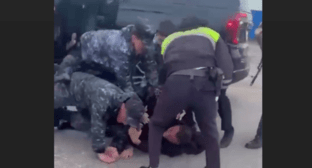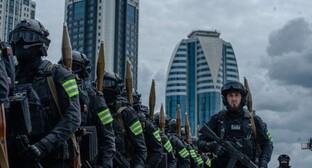14 January 2004, 23:26
The Chechens and Ingushes in the Caucasian War
The beginning of the Caucasian (Russian-Caucasian) War is dated in different ways, mainly within the first quarter of the 19th century, though according to our consideration the warfare broke out in the 80s of the 18th century, when uncoordinated resistance to the tsarism exceeded the bounds of separate regions (the Kuban Region, Kabarda, Chechnya, Daghestan) and turned into an all-North Caucasian movement advancing the precise religious-political slogans.
So, in spring of 1785 a Moslem preacher, Sheikh Mansour, or Ushurma, appeared in Chechnya, who, striving for unification of the highlanders to fight against the tsarist colonialists, called upon them for "hazavat", i.e., "sacred war" against the "unfaithful" enemy. Thus through Islam taken as an ideological basis, politically separated Caucasians of different tribes partially consolidated in the struggle against the colonial power.
In the Northern Caucasus (in Daghestan) Islam began to spread yet in times of the Arab Caliphate, though for the majority of the native peoples it was established as the official religion considerably later. Thus the Vainakhs inhabiting in the plain and foothill zones of the Caucasus apparently came into contact with this teaching not earlier than in the 15th - 16th centuries; as to the inhabitants of the mountainous part of Chechnya and Ingushetia, the influence of Mohammedanism on the highlanders was rather weak even in the 17th - 18th centuries. As is generally known, in the 18th to the early 19th century the Ingush elders swore not to the Koran but to their pagan gods despite the fact that Islam had already existed among a certain part of the Ingushes.
A striking and mysterous person of Sheikh Mansour gave rise to a number of fabulous versions about his non - Caucasian origin as far back as the end of the 18th century. He was believed to be an Italian adventurer (soldier or monk) who had adopted Islam. Some considered him a descendent of Shah Nadir, the ruler of Persia, others attributed him to the Poles. It was also rumoured that he had come from the Orenburg steppes. However, these considerations have been rejected scientifically as having nothing in common with the historical truth. It is proved scientifically that Mansour was Chechen by birth.
Ushurma was born in 1760, in a poor family, in the village of Aldyi (the Chechen Plain). In his youth he pastured cattle and tilled the soil. He got married at the age of 22 and had three children. Owing to his mode of life of high moral standards, wit and strong character, Ushurma was held in high respect by the countrymen even when he was young in years. Although Ushurma was illiterate, he was a brilliant orator and subtle psychologist.
In 1785 Ushurma began an active religious and political activity. Due to his preachings Ushurma became far-famed and enjoyed the support of the influential mullahes and theologians of Chechnya, who declared him sheikh and gave him the name "mansour" which means "victor" in Arabian.
The highlanders, not only peasants and ordinary people but also the representatives of feudal nobility, came from everywhere to listen to Mansour. Apart from the Chechens, among his numerous followers were the Kumyiks, inhabitants of mountainous Daghestan, Adygeis, Ingushes, Ossets, Nogais? The Russian command kept vigilant watch of the processes taking place over the river Terek and in summer of 1785 sent a military unit three thousand strong under the command of Colonel Pierry against the village of Aldyi, where the Imam had his seat, to capture the "false prophet and restore calm and order violated by him in that region". Having left part of the troops for guarding the crossing across the Sunzha, Pierry and his main armed forces (three infanry battalions and a Cossack sotnia (squadron) with two guns) burst into the aul abandoned by the inhabitants and committed it to the flames. The chastisers failed to find Mansour, but on their way back when moving through the forest, they fell into the ambush laid by the Chechens. Pierry was killed in the battle and it ended in an utter rout of the Russian detachment. According to official data, 8 officers and 414 soldiers were killed, 162 of the enemy were made prisoners and an overwhelming majority of the survived were wounded. The highlanders captured both of the guns.
This victory has brought a great fame to Mansour. The Russians had not been defeated in the Caucasus since their unsuccessful campaign organized against Daghestan in the early 18th century, therefore, the fellow-fighters of the Sheikh did not fail to proclaim the results of the battle to be the fulfilment of his prophecy. The number of Mansour's supporters and followers was increasing at still faster rates. That was the period of the utmost general enthusiasm.
Striving for exploitation of his success, Mansour assaulted the centre of the Russian domain in the North-Eastern Caucasus, Kizlyar, but the storm was repelled. The highlanders managed to capture one stronghold only, which covered the Terek crossing in the environs of the city. At night the army of the Sheikh got lost in the marshland when, all at once, was attacked by the Cossacks. So, the mountaineers, having suffered heavy losses in killed and wounded, had to retreat.
The same fate befell the mountaineers when taking Kizlyar by storm for the second time and when they were breaking through Kabarda to join the local rebels. In the battle which took place in the vicinity of ancient ruins of Tatartup the Russian forces defeated the detachments of the highlanders (Chechens, Kabardians, Kumyiks and others) and threw them back. In 1787 Mansour was impelled to flee to the Kuban Region where, at the head of the Adygei detachments he, in alliance with the Turks (the Russo-Turkish war of 1787-1791 was in progress), continued to fight against the Russians, though in 1791 in the battle for Anapa Mansour was captured by the Russians and died in casemate of the Slisserburg Fortress. (According to another information Mansour died on the Solovetsk Islands).
Proceed from the afore-said Sheikh Mansour, or Ushurma, a Chechen from the village of Aldyi, was the first great organizer of the liberation movement of highlanders against tsarist Russia in the Northern Caucasus. The activity carried out under his command, though religious but anticolonial in its essence can be in fact regarded as the beginning of the Caucasian War.
During the first ten years of the 19th century tsarist Russia annexed part of the territories of Georgia and Northern Azerbaijan. The newly formed provinces were connected with the parent state by the only existed road running through the Daryali Pass which is rightfully called the Georgian Military Road.The Ossets, inhabiting to the west of this strategic highway, had been considered to be subject to the rule of the Russian Empire since 1774, but the Ingushes, living to the east of this road, maintained their independence. Meanwhile, in order to ensure the safety of communication with Tiflis (Tbilisi), the centre of Russia's domains in the south, it was necessary to bring the tsarist troops into Ingushetia and subordinate the country to the Russian control.
Acting according the principle "divide et impera"(1) the Russian authorities succeeded in provoking the armed skirmish between the Chechens and Ingushes (June 5, 1810) just with a view to display the "care" for the Ingushes and naturalize them in Russia. Commander-in-chief of the Russian troops in the Caucasus, General Tormasov charged the commandant of the Vladikavkaz fortress with a mission to take the opportunity and submit the Ingushes to the Russian Empire. And really, an official Act of voluntary rapprochement of Ingushetia with Russia was signed between the representatives of the Ingush people and Russian military administration on August 22, 1810 in Vladikavkaz. According to the terms of the treaty the Ingushes were under the obligation to assist the Russians in defending the Georgian Military Road from the attacks of the hostile tribes, and accommodate the Russian armed forces in Nazran, a newly built stronghold in the upper reaches of the Sunzha. In return for this on behalf of the Russian government the Ingushes were promised to obtain "justice", "profit", "advantages" and protection from the enemies.
Besides that the Ingushes were given a promise that the lands occupied by them in the plain as well as on the right bank of the Terek would be in their possession for ever(2).
According to the Act of 1810, however, only the flatland of Ingushetia was taken under the control of Russian administration. As regards the communities of mountaineer Ingushes, in the middle of the 19th century they were still considered to be "semi-submissive". The government of Russia several times sent punitive expeditions against them.
* * *After the defeat of Mansour, the Chechen Plain, stretching on the area from the Terek River to the Black Mountains, was regarded by the Russian administration as a country, dependent on the Russian Empire, though the Chechens did not consider themselves to be the vassals of Russia. As to the mountainous part of Chechnya, it was practically inaccessible for the Russian guns.
General Ermolov, allotted with unlimited military, civil and diplomatic power, was appointed commander-in-chief of the Russian forces in the Caucasus in 1816. Under his command military operations against the mounatineers were activized in order to change the course of events in favour of the Russian Empire.
Of particular importance in the extensive plan of activities, drawn up by Ermolov, was Chechnya. He intended to drive out the Chechens from the plain, press them to the mountains and bereaving them of the fertile fields and pastures impell them to submit to Russia once and for all.
In the late 10s of the 19th century Russia launched a great campaign against the Chechens inhabiting the plain region. Wide openings were cut down in the forests towards the main fortifications in their struggle against the Russian colonists. At the end of the cuttings were laid strongholds connected to each other as well as to the already existed strong points by a chain of fortifications. The fortress laid in the lower reaches of the Sunzha was named "Groznaya" (the present-day city of Grozny). The conquerors were of the opinion that even the name of the stronghold should be frightening to the recalcitrants (the word "grozny" means "menacing" in Russian). In 1817 - 1823 was formed a Sunzha fortified line, dividing the Chechen Plain into two parts. The territory between the Terek and Sunzha rivers was seized by the Russians; as to the Chechens, they were banished from the places of their habitation and driven away to the foothill zone on the other bank of the Sunzha. Those highlanders only who resigned to the colonial administration, were allowed to stay on their native lands. The Russians called them the "peaceful" highlanders as distinct from the unsubdued, i.e., hostile part of the native population, who were known as "brigands", "scoundrels" and "plunderers" among the Russians.
All this would have influenced to a certain extent the native population. The discontent of the Chechens was gaining ground and getting ready to grow into the armed action which would involve the masses. In order to avoid such outcome of the affair, the Russian command resorted to the well-tried method. As a result of the punitive expeditions sent to Chechnya by the Russian command, some unsubdued auls were reduced to ashes. Sometimes the operations were accompanied by extermination of the whole population, regardless of women, children and the old.
A great misfortune befell the aul of Dadi-Yurt located on the right bank of the Terek. In September 1819 Ermolov ordered to surround the aul and "punish everybody giving no quarter to anybody".
Having learnt about the forthcoming punitive operation, a certain Cossack who was in friendly terms with the highlanders, stole up to the bank of the Terek and cried loudly in Chechnyan: "Hey, the Dadiyurtians! Your aul will be surrounded and destroyed in three days! Go away!" People in the aul heard this warning but did not attach great importance to it. On September 14 Dadi-Yurt was attacked by the chastisers (six infantry companies and seven hundred Cossacks with 5 guns). In an unequal battle the Chechens defended themselves desperately, women and children helped the warriors who had to take each saklia (dwelling of Caucasian peoples) by storm. The aul was razed to the ground and nearly 400 people, i.e., more than half of its population, were killed. The chastisers lost in killed and wounded 230 soldiers and officers.
This kind of measures, however, only poured oil on the flame. In response to devastation of the auls the inroads on the cordon line became more frequent. The Chechens more frequently co-ordinated their activities with the Avars and other peoples of the Caucasus. On the night of July 25, 1825 they captured by storm and destroyed one of the Russian strongholds on the Terek. 98 were killed and 13 were captured out of 181 soldiers in garrison of the fort.
A Chechen leader Beibulat Taymiev (Taym Bibolt) gave much trouble to the Russian command. Beibulat had great influence on his compatriots, as well as on the neighbour peoples of the Northern Caucasus; he was elected chairman of the "Mekh-khel", i.e., Council of the country. For many years this "main Chechen horseman", as Beibulat is called in official reports, gave no rest to the tsar's generals (his first raid on the other bank of the Terek Beibulat made in 1802), until he was killed treacherously in 1831.
Yielding to the Russian regular army in organization and military might, the Chechens worked out the tactics of partisan warfare enabling them to fight against the enemies for years. V.Potto, Russian military historian, describes the character of military operations in Chechnya:
"When marching in Chechnya the Russian troops, as rule, were not showed any kind of resistance in open localities. But once a forest came in sight, a heavy skirmish broke out, seldom in the vanguard, more frequently - in the lateral chains and almost always - in the rear-guard. And the denser the forest was the heavier the skirmish was... This is how things stood until the soldiers steadily kept the order. But the trouble was if the chain became weaker or fell apart in any place; hundreds of sabres and daggers would arise in front of it as if from under the ground at once, and a slaughter would begin, as the Chechens are as agile and ruthless as tigers".
Towards the beginning of the 19th century the Chechens had a reputation of militant and unsubdued people. From a position of the tsar's military leader General Ermolov called them "the most dangerous villains". Ermolov directed his subordinates "to trouble the Chechens more frequently... catch the people, cattle, horses, burn the bread, lay, in other words, damage them as much as possible". His directions were executed diligently. The Russian servicemen believed that with the "Aziats" should be used only force.
In taking the punitive measures the tsar's authorities followed the principle of mutual guarantee. For the fault of separate persons the whole communities and tribes were punished. For example, it happened in 1825 in the stronghold of Gherzel-Aul. The Russians gathered there 318 peaceful Chechen and Kumyik elders. Two generals made their speeches at the meeting, heaping insults and threats on the highlanders as they were suspected of having connections with those people who participated in raids. All of a sudden one of the highlanders snatched out a dagger and stabbed the generals with it. One of them was killed on the spot and the other was mortally wounded. In response to this the soldiers standing on the watch slaughtered all the elders who were at the meeting.
This incident caused a storm of resentment in Chechnya and Ingushetia. The inhabitants of those Kumyik auls, which had been subjugated long before, sent a messenger to Beibulat and begged him for help. The precarious situation impelled Ermolov to lead the punitive expedition personally. In a fierce battle waged on the river Arghun on January 30, 1826 the Russian troops gained the victory.
In 1832 general Rosen, one of the successors of Ermolov on the post of a commander-in-chief in the Caucasus, having devastated 60 auls, destroyed Chechnya and mountainous Ingushetia.
The atrocity of the conquerors, however, only strengthened the resistance of the highlanders. In the 20s of the 19th century in the North-Western Caucasus a new uniting movement begins setting up under the name of "muridism"(3) - a certain variety of Islam, as a consequence of which a theocratic state - Imamate was formed in the highlands of Daghestan and Chechnya. In 1834 its leader becomes Shamil (1797-1871), a talented statesman and commander. Under his leadership the Chechens and Daghestans retained their independence yet for 25 years in the fight against the Russian Empire.
In a permanent military resistance against a powerful empire the Chechen-Daghestan Imamate needed battleworthy armed forces. So every male inhabitant, able to carry arms, was considered to be responsible for military service. Only the inhabitants of several villages, producing firearms, coldsteal(4) , gunpowder, etc., were free from military service. According to the 1841 census in Imamate battleworthy male inhabitants totalled 65 thousand. As for Russian sources, they say that in his disposal Shamil had permanent army of 5 thousand and people's volunteer corps of 48 thousand. Additionally, Imam had private Guards consisting of about a thousand most selected soldiers. There were a lot of Chechens among the guardians (murtazeks). Yet it was impossible to concentrate all forces on one operating direction. During the war the biggest army Shamil could deploy simultaneously was 12 thousand strong (march to Georgia, 1854).
Imamate was divided into the military administrative units - naibats, the quantity and size of which changed frequently. The naibats were headed by naibs appointed by Shamil. They were entrusted administrative, military and judicial power. Every naib had a staff of officials and permanent detachment of Murid warriors. Besides, naibs collected the people's volunteer corps in the whole country and commanded them during the military operations. As a rule, a family had to send one armed warrior (any fully armed highlander had a flintlock, one or two pistols, a saber and a dagger), but sometimes naib declared general military service. Frequently women volunteered in defending the auls. They not only assisted the warriors but also fought together with men.
In 1839 the tsarist command made a decision to put an end to Imamate by a double attack on Daghestan where there was a center of Murid movement for that time. A culmination moment of this bloody drama became an attack on a mountainous aul of Ahulgo, the main residence of Imam. 3 thousand Russian soldiers and officers besieged it. Ahulgo fell. Wounded Shamil together with his few survived comrade-in-arms hid himself in Chechnya.
Triumphant news flew to Petersburg about the "suppression" of Daghestan but the rejoice soon revealed to be premature. Shamil, supported by the Chechens, counterattacked the Russians and banished them from a considerable part of the Daghestan highlands in a short time.
A period of Shamil's most successes comes for the early 1840s. The Chechens took a great contribution to that. Most of them joined the movement. After Ahulgo's destroy the political center of the Imamate was shifted to Checnya. Dargo and Vedeno became the following residences of Shamil. In response, the Russian command strengthened the military pressure on Chechnya. In 1840 General Galafeev passed through the country reducing everything to rubbles and ashes. On July 11 at the river Valerik the Chechens attacked a detachment of Galafeev who hardly broke off, losing 29 officers and 316 soldiers. M.Lermontov, a great Russian poet witnessed the battle. He described it in his poem "The Valerik".
Neither a repeated expedition undertaken in autumn of the same year, nor punitive marches in 1841 had tangible results. In the beginning of the 1840s as a result of permanent offenses of Russian army, a half of auls of the Chechen Lowland had already been burned, though the Russians could not subdue the Chechens, and no sooner had the army returned to its base than the highlanders come upon the cordon line again, reaching Mozdok and Kizlyar at times.
In the spring of 1842 General Grebbe, the conqueror of Ahulgo, invaded Chechnya with great forces but he suffered a hard defeat in the Ichkerian forests, losing in killed and wounded nearly 2000 soldiers.
In 1843 Shamil attacked the royal forces and put them to rout in Daghestan. The highlanders seized 13 fortified points and booty: tens of sub-machine guns, great number of ammunitions and provisions.
In 1844 Emperor Nicholas I, dissatisfied with the activities of his army in the Caucasus, appointed Prince Vorontsov Vicegerent and Commander-in-Chief there, entrusting him extreme power. In may 1845 Vorontsov with an army of 25 thousand soldiers, 46 guns and cavalry 2 thousand strong intruded far in the mountains and seized aul Dargo, the residence of Shamil. In the whole, though, Vorontsov's expedition was not successful. His army was besieged and survived only thanks to a reinforcement with General Freigat in head who arrived there to rescue them. According to official data, in this expedition Russian casualties totalled 3,967 people, with 3 generals among the dead. According to unofficial sources, the figure of Russian casualties is considerably high.
In April 1846 Shamil with Chechen-Daghestan volunteer corps 10 thousand strong intruded into Kabarda in order to unite with the Adygeis and form a solid anti-Russian front from Daghestan to the Black Sea. But the plan turned to be unrealizable, in the main, due to the passiveness of the Kabardians who took a temporizing position. The Russian command, mobilizing all forces, asked for reinforcement from Tbilisi through the Georgian Military Road. Shamil sent part of his army to Daryali Passage in order to cut off communication with Georgia. But the Ingushes and Ossets destroyed Imam's plans. They did not allow his detachments to cross their territories. Shamil had to return to Chechnya. He was followed by a small group of Kabardians who joined his army.
From 1846 Vorontsov renewed Ermolov's tactics: the Russian army slowly advanced deep in the mountains by contracting the Imamate with a circle of reinforcement and methodically destroying the recalcitrant auls. Shamil tried several times to break through the blockade but the highlanders' forces were fading out. As to the Russians, they unceasingly sent new units and formations to the Caucasus. In the second part of the 50s the empire had already an army 350 thousand strong in the Caucasus, the main forces of which (about 2,000,000 soldiers and officers) acted against Checnya and mountainous Daghestan surrounded by the Russian domains. Thanks to overwhelming numerical superiority and at the price of heavy casualties the Russian army could break the resistance of Shamil's main forces. Vedeno, a fortified aul and the capital of Imamate since 1845 was taken by storm (in February, 1859). It should be noted that among the defenders of Vedeno were quite a number of Russian deserters (turncoats) - soldiers and Cossacks - living in one of the quarters of the aul. Shamil retreated to Daghestan. Besieged on the Mt.Guniba, after hopeless fights on August 26, 1859, he surrendered to Prince Baratinsky, Commander-in-Chief and Vicegerent in the Caucasus.
When the Caucasian War ended (in 1864) hundreds of thousand highlanders left their motherland and deported to the Ottoman Empire, never wishing to reconcile to the supremacy of Russians. There were more than 20 thousand Vainakhs among the emigrants.
In 1858 the Ingushes rose in rebellion provoked by the arbitrary of tsarist administration resettling the local inhabitants from small settlements to large auls by force in order to make easier the police control over the population and use the cleared territories for colonial needs. Nearly 5 thousand rebels attacked the fortified aul of Nazran but they were defeated. Shamil's attempt to help the Ingushes did not succeed. The Ingush rebellion was subdued. Its leaders were executed; several thousands of activists were exiled from the Caucasus. Utter suppression of the Ingush highland societies by Russia belongs to the same time.
Notes
(1) Field - Marschal General Paskevich, vicegerent of the Caucasus in the 20s of the 19th century briefly formulated the main point of this policy, pointing out that "it is necessary to favour the emergence of dissent between the mountaineer tribes and help the weakest of them.
(2) It should be noted that after the end of the Caucasian War, when obedience of the Ingushes had lost its urgency for tsarist Russia, a considerable part of fertile lands was taken away from the Ingushes by force. Since then up to the 20s of the 20th century an acute lack of the arable lands had been characteristic of the Ingushes.
(3) Muridism - a mystical religious trend in Islam risen in the Middle Ages on the basis of Sufism philosophy. The aim of its followers is to come closer to the God, to "mix in Him" by means of religious and moral perfection (absoluteness). Muridists are obliged to subordinate to their mentors without demur. In the Northern Caucasus Muridism as an ideology against the tsarist policy started developing in the 19-20s. Though yet Sheikh Mansour preached some of its features. The theoreticians of highland resistance used this religious teaching for political purposes by boosting the idea about Muslims' disobedience to oppression and power of the "unfaithful" (in this case, to Russian Christians). A theocratic leader of the Muridists was titled as Imam.
(4) Coldsteal (sabers, daggers) as well as flintlocks and pistols made by the Caucasian highlanders. Military quality and artistic decoration of such weapons were far more excellent than their analogues in Russian army. That's why the Russian officers tried to acquire the Caucasian produced weapons when serving in this region. The Cossacks too preferred local weapons, though, gunpowder made in household conditions were not as qualitative as gunpowder produced in Russian factories. But the Russians' true superiority over the highlanders showed itself in an artillery. Imamate produced sub-machine guns but not of a good quality. Many of them became useless after several shots. An artillery park Shamil prossessed was made up of tens of weapons - booties and those of local production as well. The artillery service was mainly carried out by Russian deserters.




